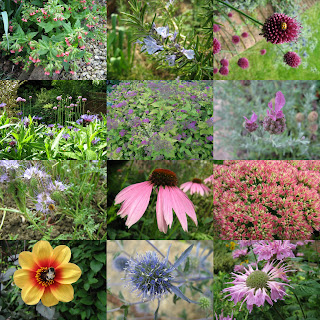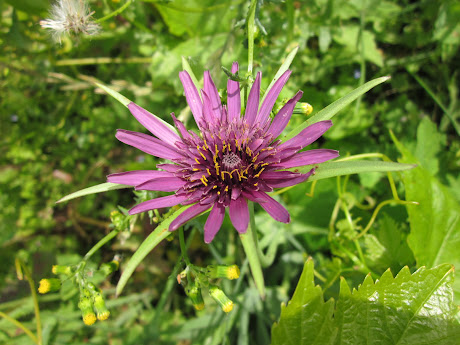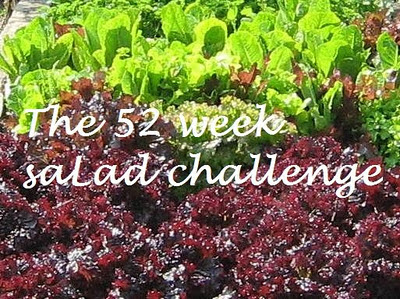Flowers for Bees: VP's Dozen

It's Tweehive time today, so once again it's a warm welcome to both my regular readers and any new ones, especially you busy bees gathering nectar and pollen for today's task. There should be a flower popping up here for you today, plus a couple of others elsewhere - have at look at the end of this post for some clues. I thought I'd also give you a nice collage of bee friendly plants found in my garden.
From top left reading clockwise (and you can click on the image to enlarge it if you want to) they are:
- Pulmonaria saccharata 'Redstart' - note I'm showing a plain leaved pink cultivar because this flowers much longer for me than the nicer, spotty leaved ones - from December until April
- Rosmarinus officinalis 'Prostrata'
- Allium sphaerocephalon
- Lavandula stoechas - I prefer Lavandula angustifolia, but I don't seem to have a decent photo to hand
- Sedum 'Autumn Joy'
- Monarda aka bee balm 'Croftway Pink'
- Eryngium - I think it's a different cultivar to the alpina the supplier said it was
- Dahlia 'Moonfire'
- Phacelia tanecetapholia up at the allotment - a couple of years ago I must have had most of the bees up there as I had plenty foraging away on this, but everyone else was moaning about the lack of them on their plots!
- Centaurea montana - with a sneaky extra bee friendly allium
- Spirea japonica 'Goldflame'
- Echinacea purpurea.
You might be surprised I'm naming some plants which flower during the winter in my garden, but bees will still need to forage on the odd warm winter's day and my Pulmonaria and rosemary will be there to welcome them when they do. If you'd like a much bigger list of plants to choose from, then look no further than the Bumblebee Conservation Trust's list - their website is well worth a look for lots of information about bees in general and other ways you can help in their conservation.
 Just like a baker's dozen, I'm going to add a thirteenth flower to my list. As you can see it's Erysimum 'Bowles Mauve'. I manage to keep this in bloom for 12-36 months, so it's on-hand year round for any passing bee who wishes to avail itself of its riches. It's also slightly scented, so it pleases me too.
Just like a baker's dozen, I'm going to add a thirteenth flower to my list. As you can see it's Erysimum 'Bowles Mauve'. I manage to keep this in bloom for 12-36 months, so it's on-hand year round for any passing bee who wishes to avail itself of its riches. It's also slightly scented, so it pleases me too.BTW did you see the item on the national news a couple of days ago about encouraging keeping bees in cities using a new kind of plastic hive? I must remember to ask my beekeeping friend S what he thinks on that one.
NB It's also Emma's blog carnival day, so she'll also have plenty about bees there today. I suspect she'll also be taking part in the Tweehive again. Do have a look here for further information on what this is all about. If you're playing the Tweehive game, you'll find further flowers to plunder at my bee related posts last month - Voice of the Tweehive and Norfolk Lavender...
Don't forget it's also 12:34:56 on 07/08/09 meme time. I'll be posting my effort later ready for you to add your comments and links to what you've been up to at that time today.










When the Sun bothers to shine this is such a lovely time of year with some of my favourite flowers out. May the Bees always pollinate your lovely flowers and the rain fall just in time to stop them wilting.
ReplyDeleteI see plenty of bumble bees but I have never seen any honey bees in my current garden. I assume that no one keeps bees in the area!
ReplyDeleteBest wishes Sylvia
VP .. thought provoking post "bee-witching" in fact girl ! tee hee
ReplyDeleteI just looked back at last year's August postings and I am shocked how far behind we are from then .. cool wet summer is good for the garden but it has delayed some flowers .. never the less bees have a busy buffet here still ! Great "dozen" for the pick : )
Love your collage and co-incidentally have spent the day with a friend who is a butterfly fan and has planted her garden up with plants which encourage them, and also bees, hoverflies and moths. I also find old fashioned michaelmas daisies attract butterflies by the score and sedum will also be covered in them in a couple of weeks.
ReplyDeletethank you for posting this, I've been looking for just this sort of information myself.
ReplyDeleteWe have a stretch of lavender where I live and at times this summer it's been absolutely stuffed with bees, butterflies, and hummingbird hawk-moths. It was a real treat to see.
Hermes - that's one of the nicest best wishes I've ever had :)
ReplyDeleteSylvia - I find that rather hard to believe, but sad if it's true.
Joy - whilst we've just had a very wet period, I believe our summer's been far better than last year. We have many more bees and butterflies around this time.
Elizabethm - those are good choices and most of my featured plants are also good for all beneficial insects, not just bees :)
Tony - welcome! Glad you've found this useful. I'm envious of your hummingbird hawk-moths. We haven't had one in our garden for a number of years. I do have one on my current desktop picture, so I see a virtual one every day!